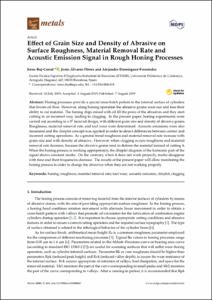Mostra el registre d'ítem simple
Effect of grain size and density of abrasive on surface roughness, material removal rate and acoustic emission signal in rough honing processes
| dc.contributor.author | Buj Corral, Irene |
| dc.contributor.author | Álvarez Flórez, Jesús Andrés |
| dc.contributor.author | Domínguez Fernandez, Alejandro |
| dc.contributor.other | Universitat Politècnica de Catalunya. Departament d'Enginyeria Mecànica |
| dc.contributor.other | Universitat Politècnica de Catalunya. Departament de Màquines i Motors Tèrmics |
| dc.date.accessioned | 2019-09-16T13:02:21Z |
| dc.date.available | 2019-09-16T13:02:21Z |
| dc.date.issued | 2019-08-01 |
| dc.identifier.citation | Buj, I.; Alvarez, J.A.; Dominguez, A. Effect of grain size and density of abrasive on surface roughness, material removal rate and acoustic emission signal in rough honing processes. "Metals", 1 Agost 2019, vol. 9, núm. 8, p. 1-15. |
| dc.identifier.issn | 2075-4701 |
| dc.identifier.uri | http://hdl.handle.net/2117/168263 |
| dc.description.abstract | Honing processes provide a special cross-hatch pattern to the internal surface of cylinders that favors oil flow. However, along honing operation the abrasive grains wear out and lose their ability to cut material. The honing chips mixed with oil fill the pores of the abrasives and they start cutting in an incorrect way, leading to clogging. In the present paper, honing experiments were carried out according to a 32 factorial design, with different grain size and density of abrasive grains. Roughness, material removal rate, and tool wear were determined. Acoustic emissions were also measured and the chirplet concept was applied in order to detect differences between correct and incorrect cutting operations. As a general trend roughness and material removal rate increase with grain size and with density of abrasive. However, when clogging occurs roughness and material removal rate decrease, because the abrasive grains tend to deform the material instead of cutting it. When the honing process is working appropriately, the chirplet diagram of the harmonic part of the signal shows constant marks. On the contrary, when it does not work properly, marks disappear with time and their frequencies decrease. The results of the present paper will allow monitoring the honing process in order to change the abrasives when they are not working properly. |
| dc.format.extent | 15 p. |
| dc.language.iso | eng |
| dc.publisher | Multidisciplinary Digital Publishing Institute (MDPI) |
| dc.rights | Attribution-NonCommercial-NoDerivs 3.0 Spain |
| dc.rights.uri | http://creativecommons.org/licenses/by-nc-nd/3.0/es/ |
| dc.subject | Àrees temàtiques de la UPC::Enginyeria mecànica::Processos de fabricació mecànica::Màquines i mecanismes |
| dc.subject.lcsh | Tool-steel |
| dc.subject.other | Honing |
| dc.subject.other | Roughness |
| dc.subject.other | Material removal rate |
| dc.subject.other | Tool wear |
| dc.subject.other | Acoustic emission |
| dc.subject.other | Chirplet |
| dc.subject.other | Clogging |
| dc.title | Effect of grain size and density of abrasive on surface roughness, material removal rate and acoustic emission signal in rough honing processes |
| dc.type | Article |
| dc.subject.lemac | Màquines-eines de tall |
| dc.contributor.group | Universitat Politècnica de Catalunya. TECNOFAB - Grup de Recerca en Tecnologies de Fabricació |
| dc.contributor.group | Universitat Politècnica de Catalunya. CREMIT - Centre de Recerca de Motors i Instal·lacions Tèrmiques |
| dc.identifier.doi | 10.3390/met9080860 |
| dc.description.peerreviewed | Peer Reviewed |
| dc.relation.publisherversion | https://www.mdpi.com/2075-4701/9/8/860 |
| dc.rights.access | Open Access |
| local.identifier.drac | 25820149 |
| dc.description.version | Postprint (published version) |
| local.citation.author | Buj, I.; Alvarez, J.A.; Dominguez, A. |
| local.citation.publicationName | Metals |
| local.citation.volume | 9 |
| local.citation.number | 8 |
| local.citation.startingPage | 1 |
| local.citation.endingPage | 15 |
Fitxers d'aquest items
Aquest ítem apareix a les col·leccions següents
-
Articles de revista [598]
-
Articles de revista [48]
-
Articles de revista [473]
-
Articles de revista [207]


